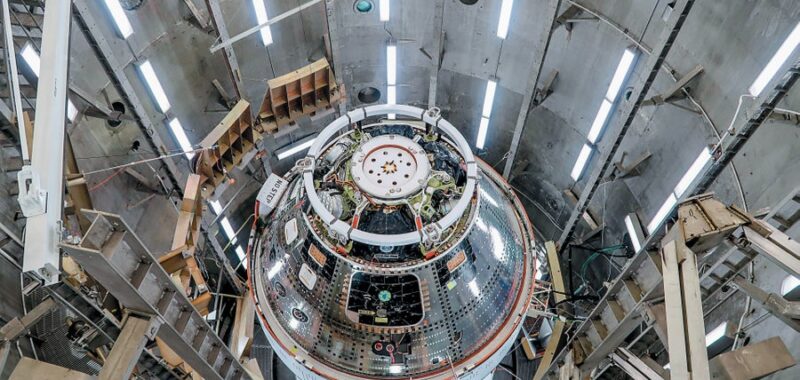When the Apollo 17 astronauts returned from the moon in 1972, they couldn’t have known that they would be the last humans to travel deep into outer space for more than 50 years. But no astronauts have ventured beyond Earth orbit since, even as Presidents George W. Bush, Barack Obama, Donald Trump and Joe Biden have all planned lunar missions. Finally, NASA is preparing to send people back to the moon on the Artemis II flight, scheduled to lift off in the fall of 2025. Why has it been so difficult?
This new mission is similar to the Apollo 8 flight of 1968, when three people circled the moon without landing and then traveled back to Earth. Artemis II will send four astronauts on a 10-day trip around the moon on the first crewed test of NASA’s new Space Launch System (SLS) rocket and Orion space capsule. Although the U.S. has had decades to get better at such journeys, the upcoming trip resembles its mid-century cousin in that it will be far from easy.
Choosing to do things “not because they are easy but because they are hard” is part of the rationale President John F. Kennedy gave in a famous 1962 speech trying to galvanize support for the Apollo program. And what was true then remains so today—in fact, reaching the moon may be even more difficult than it was decades ago.
On supporting science journalism
If you’re enjoying this article, consider supporting our award-winning journalism by subscribing. By purchasing a subscription you are helping to ensure the future of impactful stories about the discoveries and ideas shaping our world today.
NASA’s Artemis program has been plagued by long delays, cost overruns and surprise problems. It has those in common with many terrestrial programs, such as subway upgrades and highway construction, which also seem to take much longer, and often cost much more, than they did in the (dubiously) good old days. Is it really harder to build great things now? And when it comes to the moon, why should replicating a feat the U.S. accomplished more than half a century ago take so long?
Artemis’s next step is essentially an Apollo 8 redo, but the program has grand ambitions that reach beyond the moon. “In the end, our stated goal is Mars,” says Matthew Ramsey, Artemis II’s mission manager. “That’s very difficult—getting to Mars and living on Mars—and so we take it in bite-sized chunks.”
The program’s first mission, Artemis I, sent an uncrewed spacecraft around the moon and back in 2022. After Artemis II, the third through sixth installments will put people on our natural satellite and then set up pieces of the Lunar Gateway, a space station orbiting the moon. Later missions will also focus on setting up habitable camps on the lunar surface.
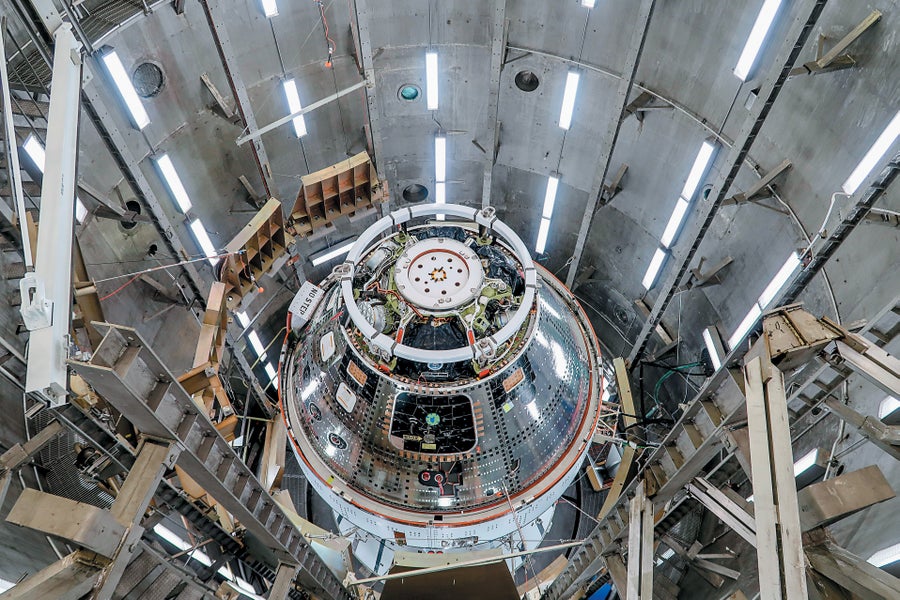
The Orion capsule for the upcoming Artemis II mission undergoes testing at Kennedy Space Center in Florida.
The Artemis program, barely off the ground, has already seen long delays, and the program faces significant problems, laid out in a recent audit from NASA’s office of the inspector general. First, it will have devoured $93 billion by 2025, billions more than anticipated. Second, the Artemis I adventure revealed “critical issues that need to be addressed before placing crew on the Artemis II mission,” according to the audit. The Orion capsule’s heat shield, for instance, broke down differently than engineers had predicted, for reasons they don’t yet understand. Bolts on the spacecraft faced “unexpected melting and erosion.” And the power system experienced anomalies that could leave the future crew without adequate energy and redundancies and maybe without propulsion or pressurization.
These “anomalies”—the term space types use for big problems—“pose significant risks to the safety of the crew,” according to the report. And they came on top of other hardware, data and communications challenges. Furthermore, the inspector general found that the initial launch caused unforeseen damage to the system, resulting in repairs to the tune of more than $26 million, a much heftier bill than the team had budgeted for. That’s a lot of hitches and a lot of money—especially for a mission that won’t accomplish many firsts we didn’t achieve back in the 1960s.
It may seem strange that today’s lunar missions are so challenging given that we’ve done this before. But the circumstances aren’t the same, says Scott Pace, director of the Space Policy Institute at George Washington University. “The world environment is very different,” he says. The U.S. is no longer in a space race—an existential battle to stay ahead of the communists and be the first to do things beyond Earth. Back then, cold war dynamics were at play, and newly independent countries were deciding which governing system to follow—a decision that might (theoretically) be influenced by a democratic nation’s ability to explore space. Such “soft power,” the thinking went, could show that the American way was the best way while using the country’s missilelike rockets to imply hard military dominance. Given those stakes, the U.S. government was willing to throw huge amounts of money at the Apollo program in a short time.
Artemis is expensive, but Apollo was exorbitant: the program cost around $290 billion in today’s dollars, according to the Planetary Society, compared with Artemis’s $93 billion. In those years NASA was often blessed with 4 percent of the nation’s budget. Today it’s lucky to get around 1 percent, with the additional burden of many other spacecraft, telescopes and research projects beyond human spaceflight to fund.
That budgetary decrease makes sense, according to John Logsdon, professor emeritus at George Washington University and founder of the Space Policy Institute. “There’s no reason to spend money like it was a war,” he says. “There’s really no national interest or political interest that provides the foundation for that kind of mobilization at this point.”
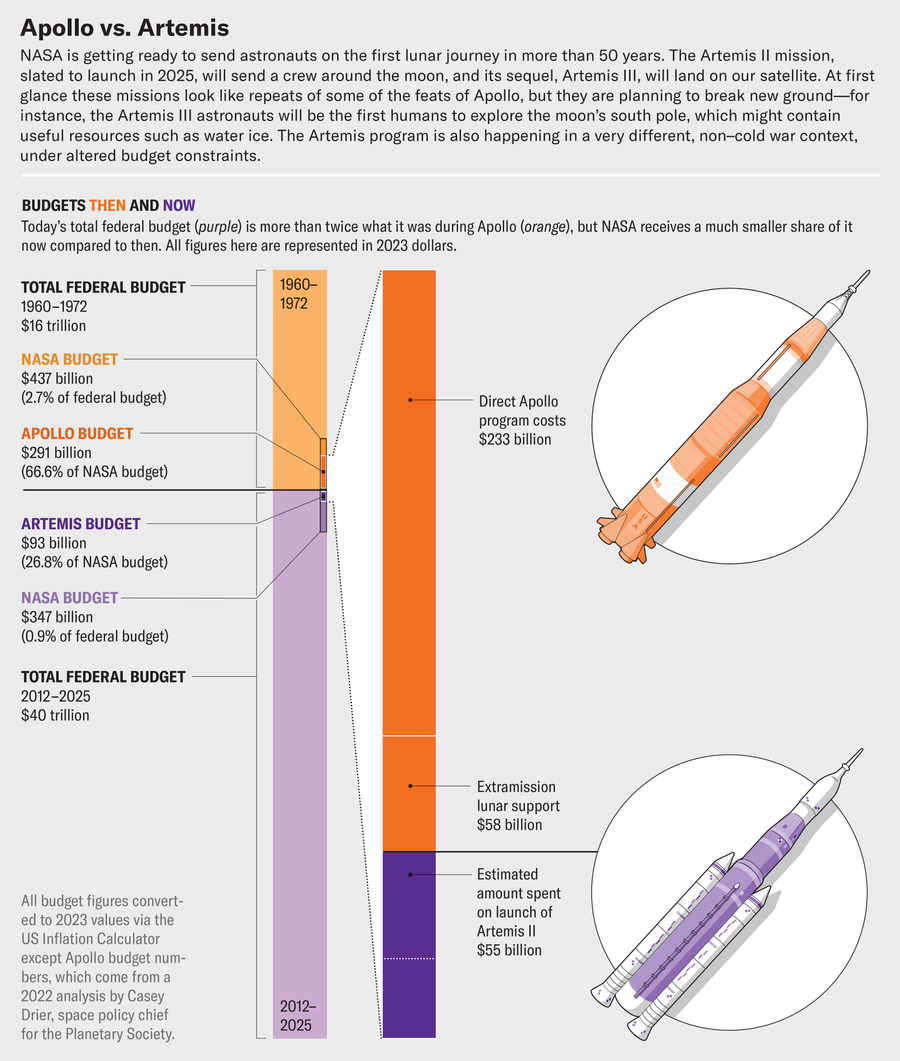
Zane Wolf (data visualization), Brown Bird Design (spacecraft illustrations)
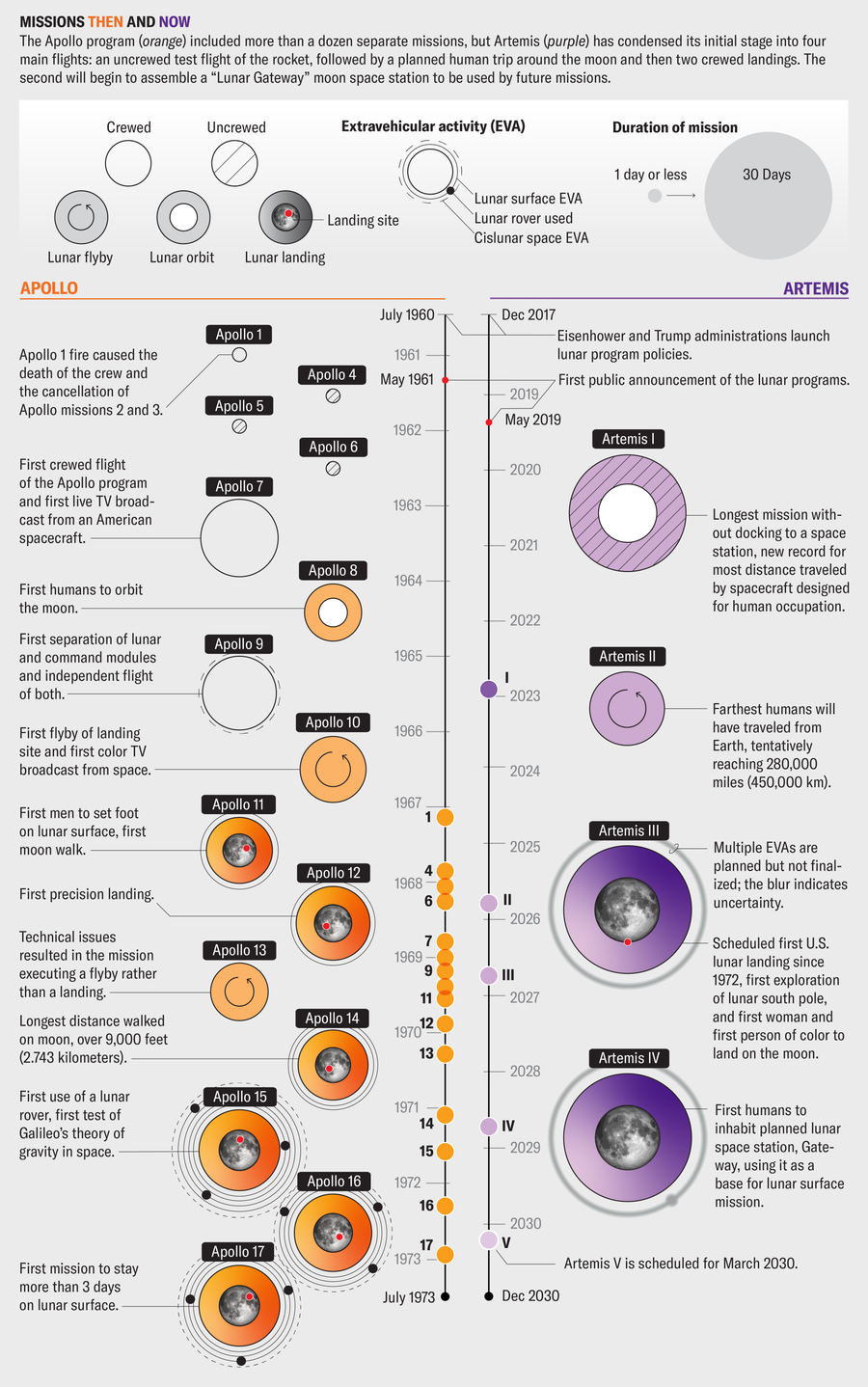
Those looser dynamics shrink the wad of cash available and set the planning of space missions on a more meandering path. In the 1960s Kennedy declared the country would go to the moon in that decade, and it did. In modern times spaceflight plans established by one president are often canceled by another, only to be resurrected later in a different form. As a result, the trajectory toward the moon (and beyond) zigs and zags.
The world order has also changed, and space missions tend to be global cooperations now, Pace notes. The Artemis program is a collaboration involving Japan, Canada, the United Arab Emirates and the European Space Agency. That international participation is in fact a big part of the program’s point. “Artemis has scientific purposes—going back to the moon and all that,” Pace says. “But it also is a way of shaping the international environment for space.” That molding is much more important than it was in the 1960s, when humans relied less on above-Earth infrastructure. Today orbiting spacecraft enable everything from GPS capabilities to missile warning to banking. Convincing other countries to see and treat space as a valuable resource, by working with them and establishing behavioral norms, helps us keep space safe and the players up there responsible. “Rules are made by people who show up,” Pace says.
That’s a more nebulous goal than winning a race. “If there were nice, sharply defined motivations, things would be a lot simpler,” Logsdon says. But working with other countries, several of whom are building hardware for Artemis, takes longer than going it alone—just as doing a group project can grate more than simply pulling a solo all-nighter. According to the NASA inspector general, the global nature of the program is also increasing the costs, and NASA doesn’t have an overarching strategy for dealing with all the partners it’s brought onboard.
In Pace’s view, however, none of those factors is the main stumbling block on the lunar trajectory. The biggest challenge, even though the U.S. has already been to the moon, is that we haven’t been to the moon recently. “We stopped, and then we forgot,” he says. Just because you ran the Olympic marathon 50 years ago, he continues, doesn’t mean you could do it again tomorrow.
In the case of Artemis, the marathon also involves new, more complicated technology. The basics of the rocket side of the equation haven’t changed that much: big rockets are essentially bombs that boost things to space. And many of the players are the same. Boeing worked on the Saturn V rocket that sent Apollo missions upward. For Artemis, the company designed and built the SLS core stage, a massive piece of machinery that stands 212 feet tall and is nearly 28 feet across. This component provides fuel to the engines that heave SLS from the ground and sends it flying the right way—courtesy of the Boeing-created avionics system that’s also onboard. The company, currently beset by controversy over quality-control issues in its planes as well as a malfunctioning spacecraft that stranded two astronauts on the International Space Station, is also responsible for rocket stages for later Artemis missions.
There are some big differences between Boeing’s antique work on Saturn V and its modern cousin. This time they built the rocket stages using computer-controlled machining, as well as a friction-based welding technique that doesn’t melt and warp metal. The company also uses computers to analyze the rocket stages’ states of being and monitor how they’re behaving in real time—a perspective Apollo lacked.
Northrop Grumman, meanwhile, handles the rocket boosters, which are strapped onto the sides of the core stage. These give SLS more than 75 percent of its oomph at launch. Much of the boosters’ engineering hails from the space shuttle program, and in some cases parts of their hardware actually flew on shuttle missions. These boosters, like missiles, use solid rocket fuel rather than liquid. “You want to get away from Earth’s gravity well and out of the thick part of the atmosphere where drag is high as fast as you can,” says Mark Tobias, SLS booster deputy engineer. “And that’s what solid propulsion really does. It’s raw horsepower.”
But the plan to use hardware from previous space programs is a bit cobbled together. The Space Launch System, for instance, was originally designed for the Constellation program, a strategy set up under the George W. Bush administration to finish building the International Space Station and to reestablish a human presence on the moon. Congress mandated that the rocket reuse technology from the then defunct space shuttle program. But Obama canceled Constellation in 2010, and in 2017 Trump anointed the Artemis program, with the goal of finally sending people back to the moon and paving the way for exploring Mars. Again, the new plan required that NASA use some of the technology that had been developed for Constellation, which in turn entailed repurposing old space shuttle technology. These mandates were pushed by congresspeople representing regions that housed manufacturing centers for shuttle parts. But the carryover and conversion of those technologies have proved difficult. According to a report from the NASA inspector general, bringing the rocket parts into the modern era—for instance, replacing asbestos parts—and retrofitting them for a new rocket system has cost much more than anticipated.
Aerospace company Aerojet Rocketdyne builds the engines, and as with the rocket boosters, making old shuttle engines work for Artemis has been hard and expensive. SLS is a much taller rocket than the space shuttle. The stretched dimensions required changing the engines to deal with oxygen flowing in at higher pressures. The engines are also closer to the boosters than they were on the shuttle. “It’s an extreme heating environment,” says Mike Lauer, director of the engine program, so it requires extreme insulation.
The Artemis engines will also experience a more irradiated environment going to the moon (and later to Mars) than they did in orbit on the shuttle. Dealing with that change involved tinkering with the computer that lives on each engine, which Lauer calls its “brain.” Those brains also needed a modernization, as computers are much different than in the 1990s (you might have noticed). The new and improved brains can monitor the engines—including during an impending disaster. “Things can be done to correct or save the mission and, in a worst-case scenario, shut an engine down before it blows up,” Lauer says. During Apollo, engineers couldn’t have known about problems fast enough to solve them. Today, he says, even though astronauts are basically riding a bomb, “that bomb is being watched very closely.”
“Artemis has scientific purposes. But it also is a way of shaping the international environment for space.”
—Scott Pace George Washington University
The retrofit was challenging, though, and required finding new suppliers because many who had worked on the space shuttle didn’t make the relevant parts anymore. Ultimately the point is this: sometimes it’s easier to design and build the house you want than to renovate a fixer-upper with a bathroom next to the kitchen and cupboards at awkward heights.
Speaking of riding bombs, NASA treats humans with a softer touch than it did in the 1960s, when it was swooping up fighter pilots and shooting them into space. That’s apparent in the design of Orion, built by Lockheed Martin.
Blaine Brown, director of Orion’s mechanical systems, and his team ran calculations about what kinds of rigors those systems would hold up against and designed them to withstand multiples of what anyone expects them to experience, whether high temperatures or intense acceleration forces. As they refine the spacecraft, engineers continue to run detailed simulations on Orion’s materials and the stresses the capsule will be under, getting down into the details of potential weaknesses in a grainy way that the slide rules of the 1960s couldn’t handle. They also do x-ray inspections of the welds and the blocks that form the heat shield, which keeps the capsule from burning up as it streaks back through the atmosphere. The team will get more data than in the past on how the space vehicle does in flight—just as the rocket contractors do—as well as a better ability to communicate.
“We understand way more” than engineers during Apollo did, Brown says. Still, the unexpected pops up, as with Orion’s degraded heat shield, which, despite all the fancy computer simulations, was missing chunks after its first reentry. Even with today’s computational power, there’s no guarantee of perfect results. Apollo obviously worked without that analysis. But once such predictive capabilities are available, engineers are almost under an ethical obligation to use them to understand precisely what they’ll be subjecting the astronauts to.
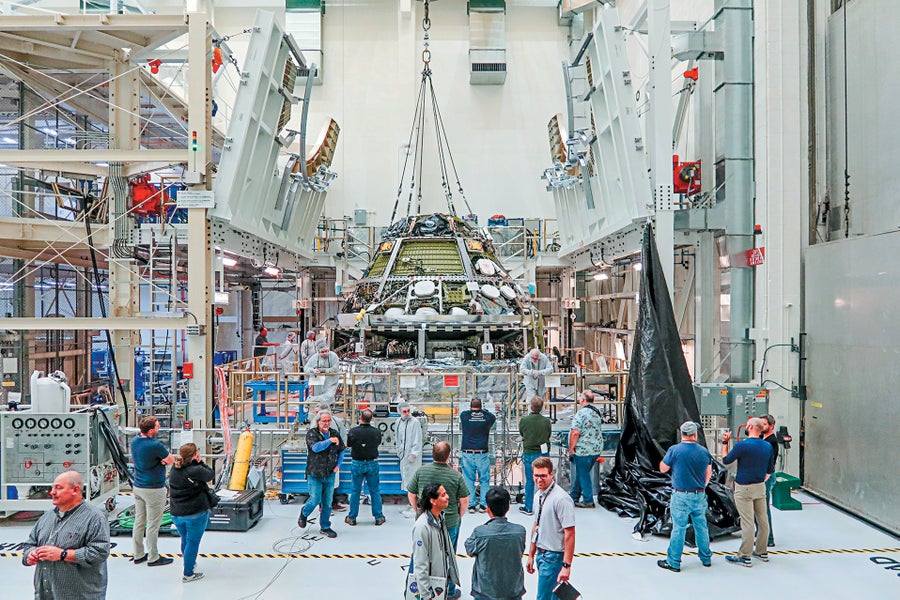
Engineers connect two parts of the Orion spacecraft, the crew and service modules, at Kennedy Space Center.
Society’s attitude toward risk has changed since the space race, says bioethicist Jeffrey Kahn of Johns Hopkins University. He’s sat on panels tasked with independently analyzing the ethics of astronaut life for the National Academy of Sciences—including which dangers are worth the trip at all. That cost-benefit equation churned out different calculations in the 1960s. The potential big reward of winning the space race against the communists was generally held to be worth more danger. Today the motivations for the mission are murkier, the stakes are lower, and the consequent rewards don’t justify as much risk.
Back then, the powers that be were also ignorant of some of the risks we now know exist, space being a new frontier at the time. Astronauts hailed from that “right stuff” mold of old. “Astronauts rode motorcycles and drove fast cars,” Kahn says, in addition to being test pilots. Today a wider variety of people go into space for a larger number of reasons. “Astronauts are not some separate species,” Pace says. Perhaps, then, we value their lives more like we value our own.
If something did go wrong, the reaction to that hypothetical accident would probably be more vehement than it was when, for example, three astronauts died in the 1967 Apollo I fire. After that tragedy there was minimal call for cancellation or even significant delay. Now, Logsdon says, the Artemis program might not have enough political support to survive a fatality. So Artemis II and the missions to follow all have to be as safe as they can be to continue to be at all.
Getting back to the moon isn’t the only modern challenge beset by delays and budget blowups. Many large-scale endeavors have grown harder and costlier over time. The New York City subway system, for instance, was initially built in just over four years and had 28 stops; a new subway line in the city with just three stops, finished in 2017, took 17 years. Scientists developed nuclear weapons from scratch in three years in the 1940s at a cost of about $35 billion in today’s money; the current nuclear weapons modernization program will take at least 30 years and cost more than $1.5 trillion. At the end of World War II the U.S. was whipping up an aircraft carrier a month; the most recent one took more than a decade.
Highway delays and big spending are the specialty of Leah Brooks, a professor at George Washington University’s Trachtenberg School of Public Policy and Public Administration. Her research has found that asking citizens for input on projects—a requirement of many large governmental enterprises these days—is one significant cause of road woes. This input is often part of an environmental review that is required before a project begins. Taking into consideration the “citizen voice,” as Brooks calls it, can result in more expensive routes that have fewer negative environmental impacts or are less disruptive to citizens’ lives but also might require additional mitigating infrastructure, such as sound barriers. In the past, authorities didn’t have to ask for everyone’s opinion (or care much about the environment). Take the Tennessee Valley Authority, Brooks says, an entity established in the 1930s to construct dams to reduce flooding and generate electricity. “They don’t consult anybody,” she says. “They just build it.” Kennedy didn’t choose to go to the moon because he had asked what everybody thought, either.
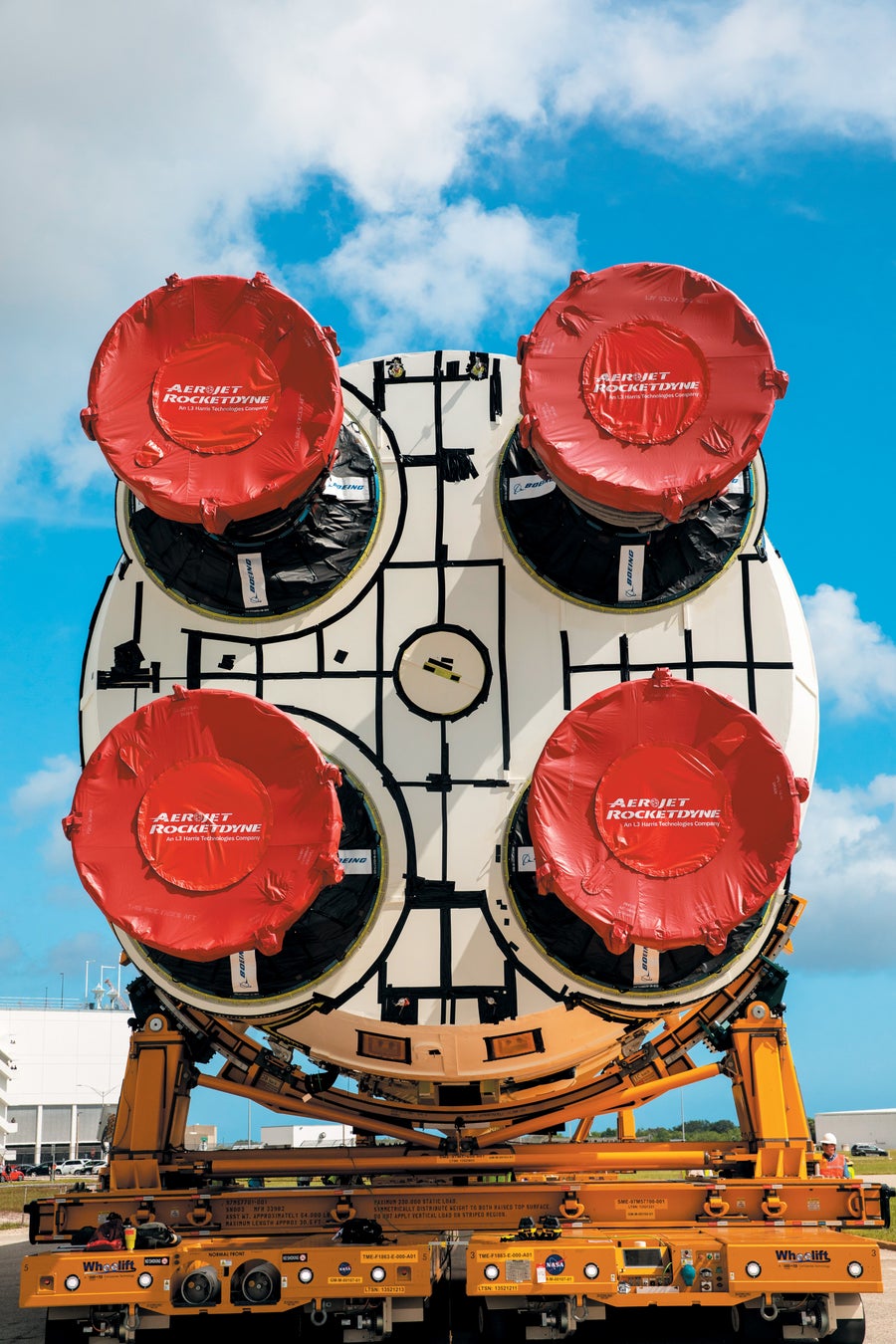
The core stage of the Space Launch System rocket traveled from NASA’s New Orleans assembly facility to Kennedy Space Center in July 2024. It will be readied there for the Artemis II mission.
Brooks’s findings may apply to any endeavor that involves an environmental impact statement—a document that lays out the consequences for the natural environment and requires an open period of public comment. One such document exists for the previous Constellation program; it was re-upped for NASA’s “post-shuttle human spaceflight program.”
In Brooks’s view, though, the biggest difference between past and present may be that we build things better now, which is expensive and takes longer. That may not be true of, say, home appliances, but it is true of those highway sound barriers and, perhaps, of spaceships. For Artemis, having a more robust rocket system, asking people what they think, keeping people safer and working with global partners are probably better for this world—even if they don’t result in expedience off-world. That lack of expedience may even be a good thing. Today, Logsdon says, you don’t hear many people arguing against the Artemis program. In contrast, Apollo wasn’t actually popular with the public. In 1961 more people opposed government-funded human trips to the moon than were in favor. In 1965 a majority opposed such trips, and in 1967 the gap between “in favor” and “opposed” had grown to nearly 20 percentage points, according to research from space historian Roger Launius.
The new way of going deep into space ultimately results in a safer, better-understood system that might meet with more public approval—at home and abroad. And besides, it’s always been true that we choose to do it because it’s hard—so what if it’s harder? And what’s the rush? It’s not a race.

